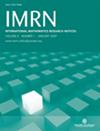Bounding Radon Numbers via Betti Numbers
IF 0.9
2区 数学
Q2 MATHEMATICS
引用次数: 0
Abstract
We prove general topological Radon-type theorems for sets in $\mathbb R^{d}$ or on a surface. Combined with a recent result of Holmsen and Lee, we also obtain fractional Helly theorem, and consequently the existence of weak $\varepsilon $-nets as well as a $(p,q)$-theorem for those sets. More precisely, given a family ${\mathcal{F}}$ of subsets of ${\mathbb{R}}^{d}$, we will measure the homological complexity of ${\mathcal{F}}$ by the supremum of the first $\lceil d/2\rceil $ reduced Betti numbers of $\bigcap{\mathcal{G}}$ over all nonempty ${\mathcal{G}} \subseteq{\mathcal{F}}$. We show that if ${\mathcal{F}}$ has homological complexity at most $b$, the Radon number of ${\mathcal{F}}$ is bounded in terms of $b$ and $d$. In case that ${\mathcal{F}}$ lives on a surface and the number of connected components of $\bigcap \mathcal G$ is at most $b$ for any $\mathcal G\subseteq \mathcal F$, then the Radon number of ${\mathcal{F}}$ is bounded by a function depending only on $b$ and the surface itself. For surfaces, if we moreover assume the sets in ${\mathcal{F}}$ are open, we show that the fractional Helly number of $\mathcal F$ is linear in $b$. The improvement is based on a recent result of the author and Kalai. Specifically, for $b=1$ we get that the fractional Helly number is at most three, which is optimal. This case further leads to solving a conjecture of Holmsen, Kim, and Lee about an existence of a $(p,q)$-theorem for open subsets of a surface.通过贝蒂数限定拉顿数
我们证明了 $\mathbb R^{d}$ 中或曲面上集合的一般拓扑拉顿类型定理。结合 Holmsen 和 Lee 最近的一个结果,我们还得到了分数海利定理,并因此得到了弱 $\varepsilon $ 网的存在以及这些集合的 $(p,q)$ 定理。更准确地说,给定${mathbb{R}}^{d}$的一个子集族${mathcal{F}}$,我们将通过所有非空${mathcal{G}}$上的$\bigcap\mathcal{G}}$的第一个$\lceil d/2\rceil $还原贝蒂数的上峰来度量${mathcal{F}}$的同调复杂性。\subseteq/{mathcal{F}}$。我们证明,如果 ${mathcal{F}}$ 的同调复杂度最多为 $b$,那么 ${mathcal{F}}$ 的拉顿数是有界的。如果 ${mathcal{F}}$ 位于一个曲面上,并且对于任意 $\mathcal Gsubseteq \mathcal F$ 而言,${mathcal{F}}$ 的连通分量的数量最多为 $b$,那么 ${mathcal{F}}$ 的 Radon 数是由一个仅依赖于 $b$ 和曲面本身的函数限定的。对于曲面,如果我们再假设 ${mathcal{F}}$ 中的集合是开放的,我们就可以证明 $\mathcal F$ 的小数赫利数与 $b$ 成线性关系。这一改进基于作者和卡莱的最新结果。具体地说,对于 $b=1$,我们得到分数赫利数最多是 3,这是最优的。这种情况进一步解决了 Holmsen、Kim 和 Lee 关于曲面开放子集存在 $(p,q)$ 定理的猜想。
本文章由计算机程序翻译,如有差异,请以英文原文为准。
求助全文
约1分钟内获得全文
求助全文
来源期刊
CiteScore
2.00
自引率
10.00%
发文量
316
审稿时长
1 months
期刊介绍:
International Mathematics Research Notices provides very fast publication of research articles of high current interest in all areas of mathematics. All articles are fully refereed and are judged by their contribution to advancing the state of the science of mathematics.

 求助内容:
求助内容: 应助结果提醒方式:
应助结果提醒方式:


